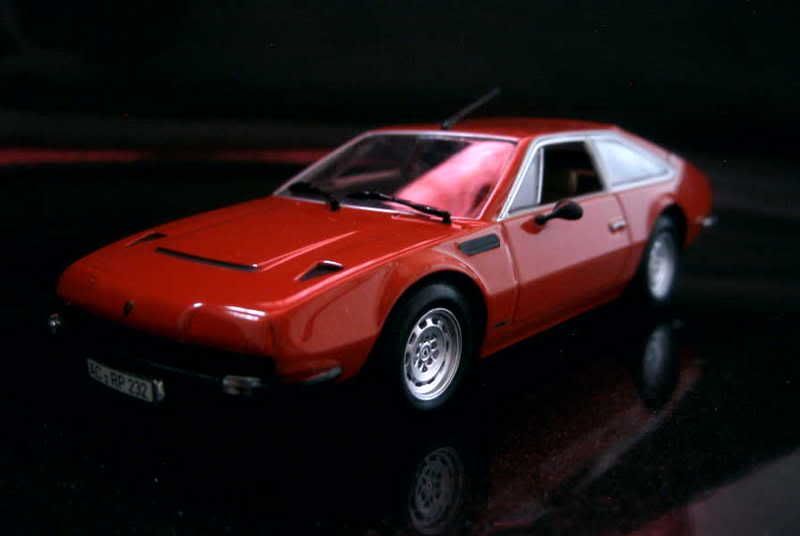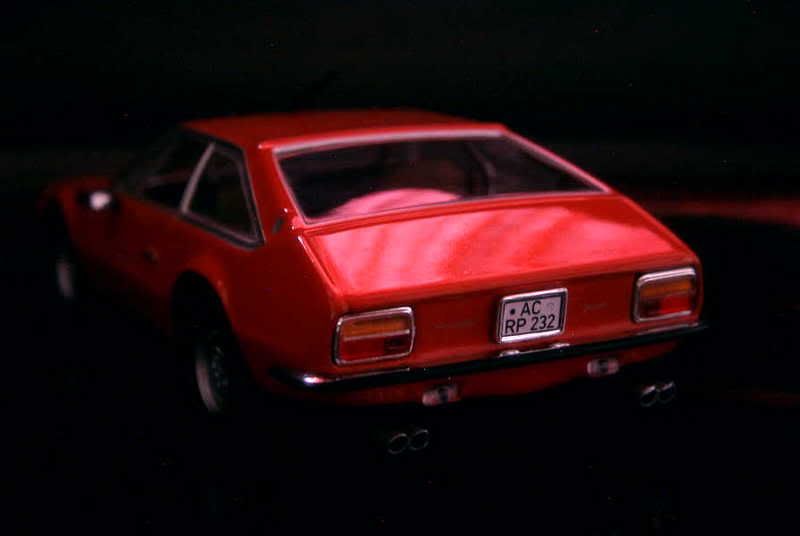A little history
Closely related to the larger Espada, the Jarama 2+2 coupe was a much shortened version of its four-seater relative, designed to replace the Islero. The curvaceous lines of the latter were replaced by an extremely angular body, penned by Marcello Gandini from Bertone. The main design feature of the Jarama was its semi-hidden headlights, fitted with electrically-operated flaps. Under this skin, the Jarama was quite much the same car as the Espada. An identical 3.9-litre V12 powered the car through a 5-speed manual gearbox which, thanks to a chassis shrunk by 28 centimetres, augured rather high performances. Indeed, with a claimed top speed of 257 kph and 0-100 kph in just 6.8 seconds, the Jarama delivered what it promised. After the car was unveiled at the Geneva motor show in March 1970, the first road tests revealed a personality quite similar to the larger Espada’s: the Jarama was perfectly stable at any speed and responded excellently on twisty roads, but steering (provided by ZF and devoid of servo assistance) was heavy, driving position was terribly tiring and dashboard had been clumsily designed. A few of these problems were addressed as they were simultaneously with the Espada, ultimately bringing a Jarama S, which emerged at the 1972 Geneva motor show. The “S” also benefited from a new version of the V12, which for the same displacement was now rated at 345 bhp. A few further modifications were added either to comply to the U.S. safety rules, as the redesigned bumpers and modified lighting, or to appeal to the American market, most notably an optional 3-speed Chrysler automatic transmission and a targa roof. These efforts certainly helped to increase the volume of sales across the Atlantic but, in the end, they proved futile to keep the Sant’Agata company financially buoyant. When the Jarama’s production was stopped in 1976, no more than a reported total of 327 had been built in six years.
About the model
Model: Lamborghini Jarama S
Year: 1974
Maker: Minichamps
Scale: 1/43
Distributed by: Minichamps, limited edition - 3,024 pieces
Acquired: brand new, in September 2007, in Manila, Philippines
I initially added this post without a comment about the model; here is to fix this problem. Actually, there isn’t much to say that I didn’t already in my previous posts about Minichamps models. Again quality and detailing are as fine as you can expect from the German die-cast maker, and almost as good as they can possibly be from an industrial brand. Only problem worth mentioning: as said earlier, the lack of photo-etched parts is the main flaw of most Minichamps models, which have to do with thick plastics wipers. As for the rest, there isn’t much to reproach. My rating is 14/20.



Closely related to the larger Espada, the Jarama 2+2 coupe was a much shortened version of its four-seater relative, designed to replace the Islero. The curvaceous lines of the latter were replaced by an extremely angular body, penned by Marcello Gandini from Bertone. The main design feature of the Jarama was its semi-hidden headlights, fitted with electrically-operated flaps. Under this skin, the Jarama was quite much the same car as the Espada. An identical 3.9-litre V12 powered the car through a 5-speed manual gearbox which, thanks to a chassis shrunk by 28 centimetres, augured rather high performances. Indeed, with a claimed top speed of 257 kph and 0-100 kph in just 6.8 seconds, the Jarama delivered what it promised. After the car was unveiled at the Geneva motor show in March 1970, the first road tests revealed a personality quite similar to the larger Espada’s: the Jarama was perfectly stable at any speed and responded excellently on twisty roads, but steering (provided by ZF and devoid of servo assistance) was heavy, driving position was terribly tiring and dashboard had been clumsily designed. A few of these problems were addressed as they were simultaneously with the Espada, ultimately bringing a Jarama S, which emerged at the 1972 Geneva motor show. The “S” also benefited from a new version of the V12, which for the same displacement was now rated at 345 bhp. A few further modifications were added either to comply to the U.S. safety rules, as the redesigned bumpers and modified lighting, or to appeal to the American market, most notably an optional 3-speed Chrysler automatic transmission and a targa roof. These efforts certainly helped to increase the volume of sales across the Atlantic but, in the end, they proved futile to keep the Sant’Agata company financially buoyant. When the Jarama’s production was stopped in 1976, no more than a reported total of 327 had been built in six years.
About the model
Model: Lamborghini Jarama S
Year: 1974
Maker: Minichamps
Scale: 1/43
Distributed by: Minichamps, limited edition - 3,024 pieces
Acquired: brand new, in September 2007, in Manila, Philippines
I initially added this post without a comment about the model; here is to fix this problem. Actually, there isn’t much to say that I didn’t already in my previous posts about Minichamps models. Again quality and detailing are as fine as you can expect from the German die-cast maker, and almost as good as they can possibly be from an industrial brand. Only problem worth mentioning: as said earlier, the lack of photo-etched parts is the main flaw of most Minichamps models, which have to do with thick plastics wipers. As for the rest, there isn’t much to reproach. My rating is 14/20.






2 comments:
I like these less known Lamborghini models, they sure have a character that i easily get attracted to. Great moedel and pics sir Laurent!
Lesser known I don't know, but let's say there's more about Lamborghini than just the Reventón. I too love the GTs from this era, may they be called Lamborghini, Ferrari, Maserati, De Tomaso, Iso Rivolta, Bizzarini...
Thanks for your nice comment, though I don't totally share your point of view regarding the quality of the pictures - as it turned out they were the only three I had in store, so I couldn't make a selection.
Post a Comment